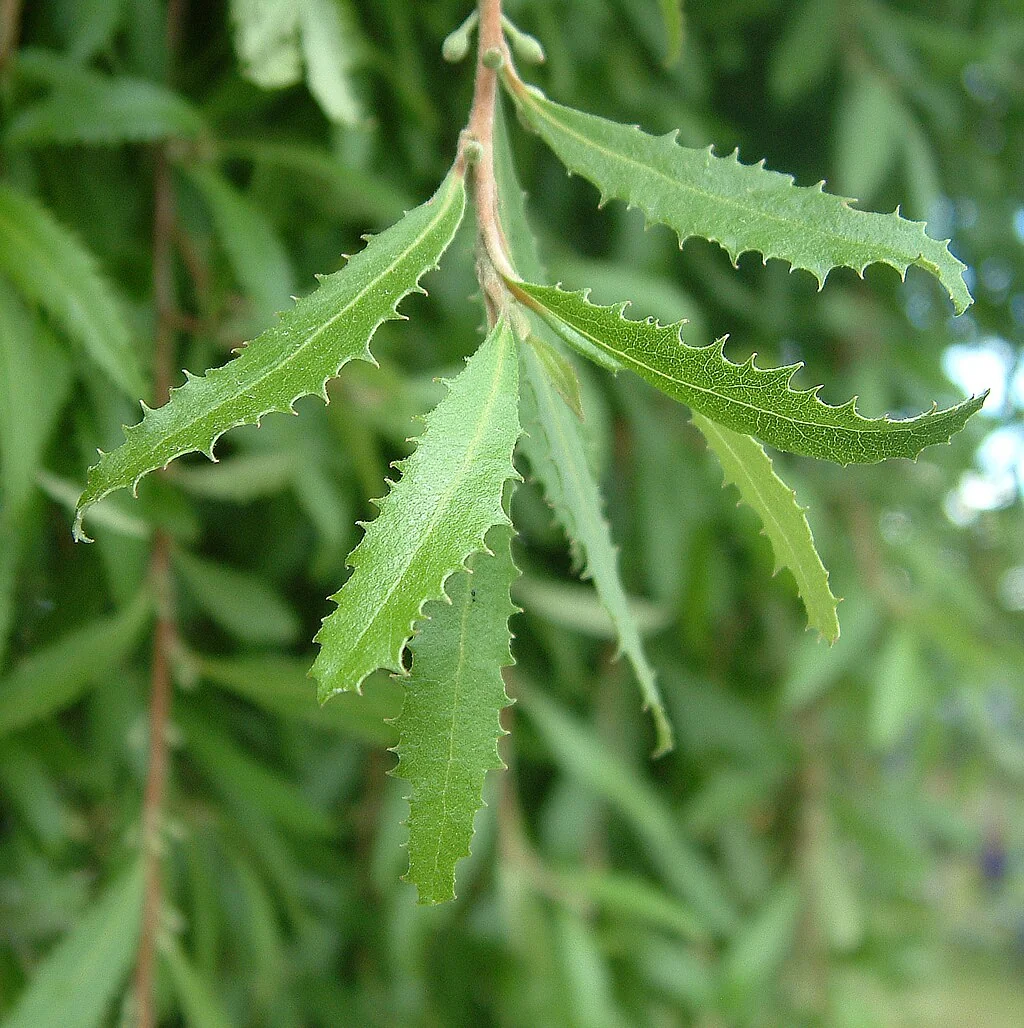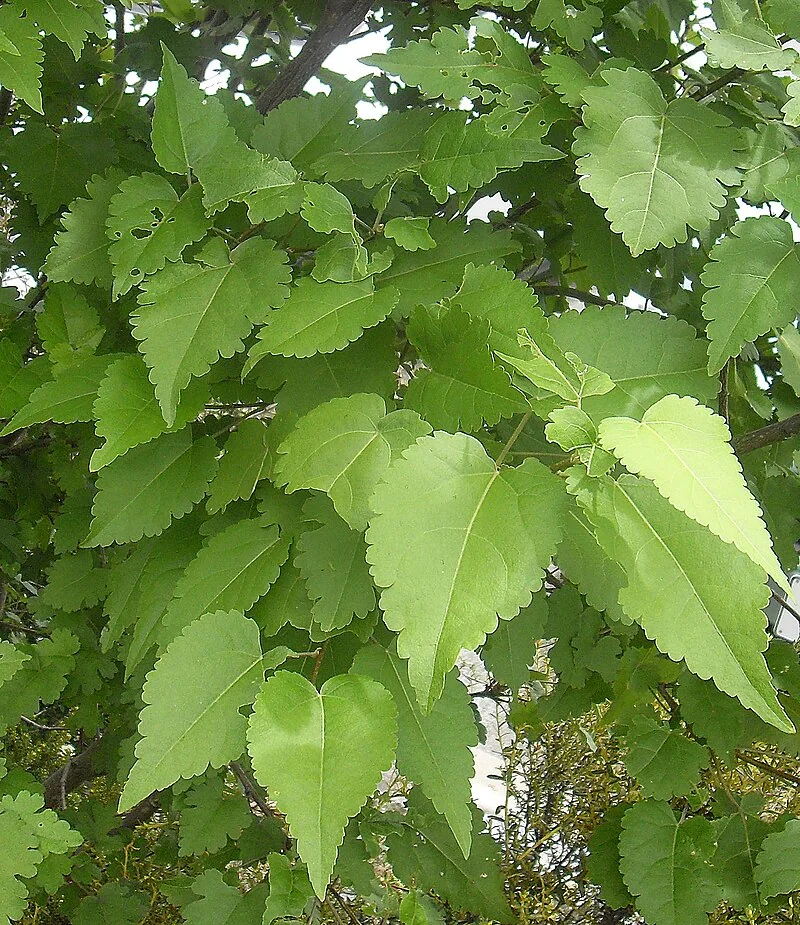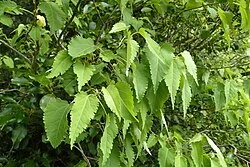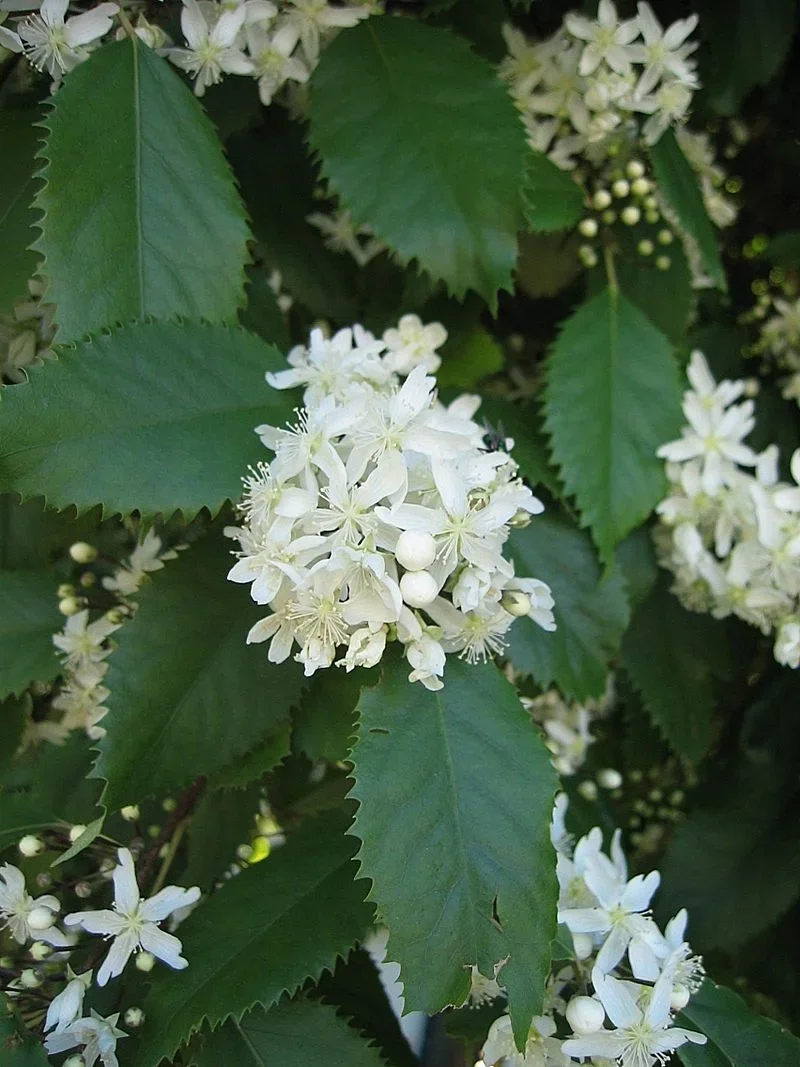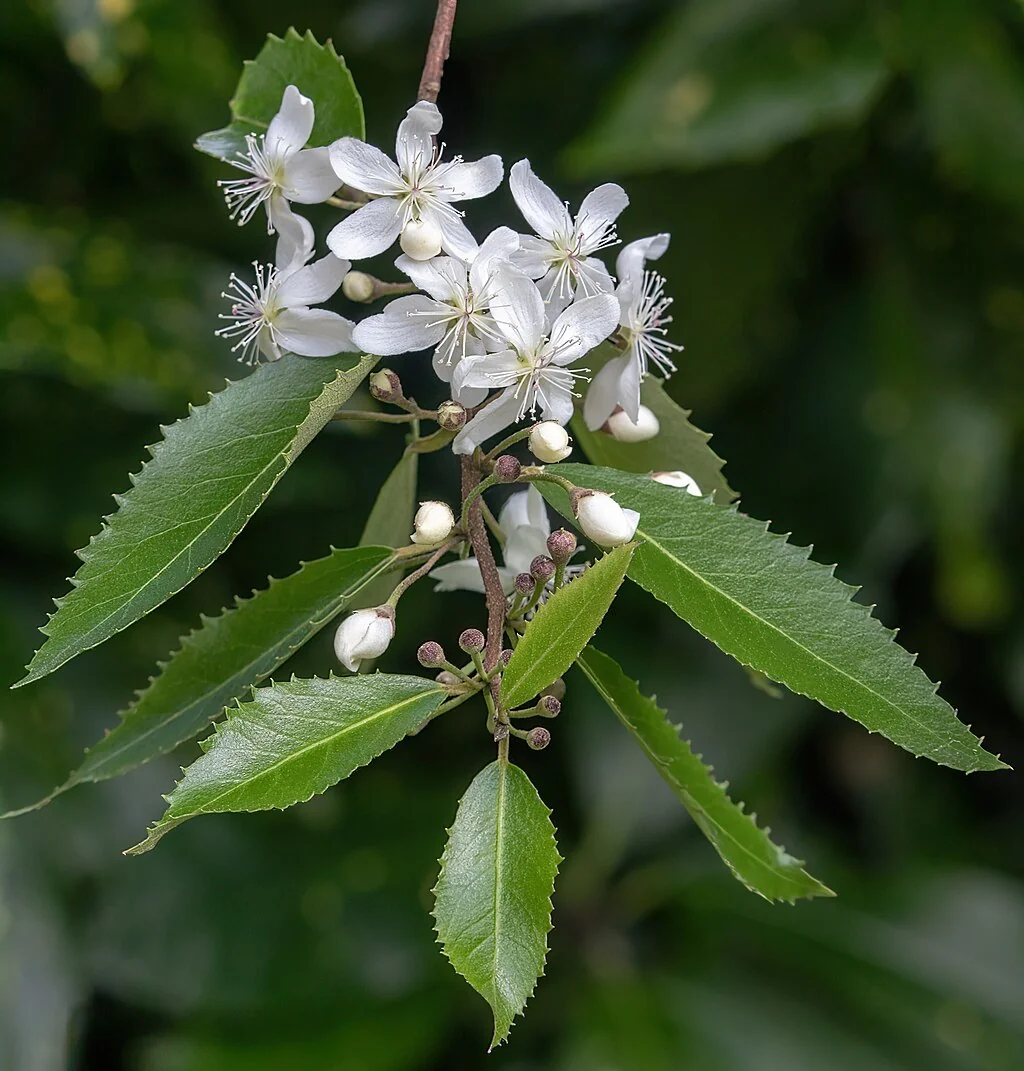
Long-leaved Lacebark
Hoheria sexstylosa
Hoheria sexstylosa , commonly known as long-leaved lacebark or ribbonwood, is an elegant evergreen tree or large shrub endemic to New Zealand. This graceful native species typically grows 8-18 meters tall and 6 meters wide, displaying an upright, columnar habit that makes it highly valued in cultivation. The glossy green foliage consists of narrowly ovate, deeply toothed leaves that are 5-15cm long and 1-5cm wide, creating an attractive dense canopy. One of its most distinctive features is the heteroblastic growth pattern, where juvenile plants produce dramatically different foliage - smaller, rounded leaves with 3-5 blunt teeth on tangled branches. The species is renowned for its spectacular late summer and autumn display of masses of fragrant, pure white, five-petaled star-shaped flowers, followed by distinctive winged dry fruits. The common name "lacebark" derives from the tree's remarkable fibrous inner bark that peels away in ribbon-like strips, historically used by Māori for rope-making and fishing nets.

Plant Description
Hoheria sexstylosa (long-leaved lacebark/houhere) is a fast-growing small tree with long, narrow leaves and prolific summer blossom of white, starry flowers. A dependable shelter and specimen tree.
Quick Facts
| Common Names | Long-leaved Lacebark, Ribbonwood |
|---|---|
| Scientific Name | Hoheria Sexstylosa |
| Family | Malvaceae (Mallow family) |
| Growth Form | Evergreen tree or large shrub |
| Height | 8-18 m tall in cultivation, up to 26 m in nature |
| Spread | 6-8 m crown spread |
| Water Needs | Moderate - prefers consistent moisture, drought tolerant when established |
| Light | Full sun to partial shade, best in sheltered position |
| Frost Tolerance | Hardy to -15°C, requires shelter from cold drying winds |
| Salt Tolerance | Moderate - tolerates warm coastal conditions |
| Growth Rate | Fast-growing when established |
| Lifespan | Long-lived (50+ years) |
| Foliage | Glossy green, narrowly ovate, deeply toothed, heteroblastic |
| Flowers | Fragrant white 5-petaled stars, summer to autumn |
| Fruit | Small winged dry capsules |
| Conservation Status | Not Threatened |
| Distribution | North Island: Waikato to Wellington; South Island: Nelson, Marlborough, Banks Peninsula |
| Habitat | Coastal to montane riparian forests, forest margins |
| Distinctive Features | Ribbon-like fibrous bark, heteroblastic leaves, masses of white flowers |
Climate Best Suited to
Suited to mild to cool temperate regions with regular rainfall. Tolerates moderate frosts and coastal winds when given some shelter from the harshest exposure. Performs best in free-draining loams with consistent moisture through summer.
Regional Suitability
| City | Climate Suitability |
|---|---|
| Whangārei | Ideal |
| Auckland | Ideal |
| Hamilton | Ideal |
| Tauranga | Ideal |
| Rotorua | Ideal |
| Gisborne | Ideal |
| New Plymouth | Ideal |
| Napier | Ideal |
| Whanganui | Ideal |
| Palmerston North | Ideal |
| Wellington | Ideal |
| Nelson | Ideal |
| Christchurch | Ideal |
| Dunedin | Ideal |
| Invercargill | Ideal |
Natural Habitat
Lowland forest margins and riparian edges across much of New Zealand, from coastal valleys to sheltered montane gullies. It favours free-draining, fertile alluvium with consistent moisture, often along streams where periodic flooding deposits silt. Young plants establish readily in light gaps and edges, later forming elegant, flowering canopies that provide shelter for understory species.
Plant Conservation
Conservation Status
Hoheria sexstylosa has a conservation status of "Not Threatened" according to the New Zealand Threat Classification System. However, the species faces some challenges related to habitat modification and distinguishing between natural and naturalised populations.
The natural distribution encompasses the North Island from northern Waikato and Coromandel Peninsula south to the Wellington Coast and Wairarapa, with South Island populations in North West Nelson, inland Marlborough, and the Banks Peninsula. Wild populations are now difficult to distinguish from naturalised ones, as the species readily establishes from cultivation.
While not currently at risk, the species benefits from cultivation in suitable gardens and arboreta, which helps preserve genetic diversity and provides seed sources for restoration projects. The tree's popularity in horticulture ensures its continued cultivation and availability for future conservation efforts.
How to Grow
Planting Guide
Best Planting Practices
Plant in late autumn to winter while soils are moist. Space 3-5 m from buildings and other trees, stake in windy sites, and mulch generously to suppress grass competition and conserve moisture. Keep mulch clear of the trunk to prevent rot.
Ecology
Masses of white summer flowers feed pollinators, and the dense canopy provides shelter and structure for native birds in mixed plantings. Lacebark can be a rapid nurse tree, improving microclimate for slower, longer-lived species.
Uses
Useful as a fast shelter or specimen tree, for screening along boundaries, and as a quick-cover component in restoration. Graceful branching and abundant blossom make it a feature near paths and lawn edges.
Landscaping Ideas
Long-leaved Lacebark integrates beautifully into diverse landscape designs, creating stunning plant combinations when paired with complementary native species. Combine it with various Pittosporum and Griselinia species, along with native grasses, to create layered shelter belts that provide both aesthetic appeal and ecological benefits. Underplant with shade-tolerant groundcovers to enhance visual interest and reduce maintenance requirements.
Seasonal Care
Winter
Plant, stake, and carry out formative pruning while dormant. Mulch to protect young roots from temperature swings.
Spring
Check ties and stakes, water during dry spells, and remove competing weeds around the root zone to boost early growth.
Summer
Deep water in extended dry periods; apply a light layer of fresh mulch if soils dry out, keeping bark away from the trunk.
Autumn
Tidy any storm damage and reduce stakes as trunks strengthen. Top up mulch and review shelter where exposure is severe.
Pruning
Pruning Techniques
Undertake light formative pruning to establish a balanced framework. Gradually lift lower branches if a clear trunk is desired; avoid heavy summer cuts which can stress the tree.
How to Grow Long-leaved Lacebark
Long-leaved Lacebark grows best when you match its natural habitat: prepare well-drained soil, get the light right, water steadily, and protect from extremes during establishment. Dig wide planting holes twice the width of the root ball, set the crown at original depth, water thoroughly to settle, and mulch with coarse organic matter to conserve moisture while keeping the stem base dry. Choose a sheltered site protected from strong winds until plants become fully established, as young trees can be vulnerable to wind damage. Feed lightly in spring with a balanced fertilizer; heavy nitrogen is unnecessary and can weaken growth while encouraging soft, pest-susceptible tissue.
Seed
Long-leaved Lacebark is particularly easy to propagate from fresh seed collected during the fruiting period from April to August. Sow fresh, viable seed immediately onto a free-draining seed-raising mix, covering lightly with fine grit to maintain moisture while preventing fungal issues. Keep evenly moist in bright, indirect light away from harsh afternoon sun, maintaining temperatures around 18-22°C for optimal germination. Germination timing varies considerably from 2-8 weeks depending on seed freshness and environmental conditions. Seeds benefit from brief cold stratification if stored, though fresh seed germinates most reliably. Prick out seedlings carefully once roots hold the growing media firmly and gradually harden off before transplanting to permanent positions.
Cuttings
Strike semi-hardwood cuttings in late spring to summer when current season's growth has begun to firm up. Select healthy shoots 8-12cm long and remove lower leaves to reduce transpiration. Use a coarse, free-draining propagation mix under gentle bottom heat (20-22°C) and maintain high humidity with regular misting. Reduce leaf area by cutting large leaves in half to minimize water loss while maintaining photosynthetic capacity. Ventilate progressively as root development occurs, typically within 6-10 weeks, and pot on to individual containers before planting out the following season.
After-Care
Maintain an open organic mulch layer, irrigate deeply but infrequently during drought periods in the first growing season, and undertake light formative pruning to build a resilient branching framework. Gradually adjust shade, wind exposure and watering regimes as plants establish, monitoring for signs of stress such as leaf browning or wilting. Refresh mulch annually for long-term soil health and moisture conservation, always keeping mulch materials away from direct contact with the trunk to prevent rot issues.
Pests and Diseases
Common Problems and Solutions
Generally healthy; passionvine hopper and scale can cause sooty mould on leaves and stems. Encourage natural predators, prune for airflow, and avoid excessive nitrogen which worsens soft, pest-susceptible growth.
Cultural Significance
Traditional Uses and Values
The genus name Hoheria is a Latinisation of the Māori name "houhere," reflecting the deep cultural connection this tree has with New Zealand's indigenous heritage. The common names "lacebark" and "ribbonwood" describe the tree's most distinctive feature - its fibrous inner bark that peels away in lace-like, ribbon-like strips.
This unique bark characteristic was of great practical importance to Māori, who expertly harvested and utilized the tough fibrous material for making ropes, fishing nets, and cordage. The inner bark was carefully removed and processed into strong, flexible fibers that were essential for traditional fishing and hunting activities. Māori also experimented with using the bark fibers for making paper cloth (aute), demonstrating their innovative approach to utilizing native plant materials.
European settlers continued to value the tree's unusual bark properties, using the fibrous strips to make ribbons for trimming hats, bonnets, and dresses - hence the alternative common name "ribbonwood." This practical use helped establish the tree's reputation in colonial New Zealand society.
Today, Long-leaved Lacebark is highly valued as an ornamental tree, with the cultivar 'Stardust' receiving the Royal Horticultural Society's Award of Garden Merit. The species represents an important part of New Zealand's indigenous flora heritage and continues to be celebrated for both its practical historical uses and its outstanding ornamental qualities in modern landscaping.
Bonus Tip
Expert Growing Advice
Plant young trees with firm staking and remove ties early to prevent rubbing. A sunny, sheltered position produces the showiest bloom and a tidy, upright habit.
